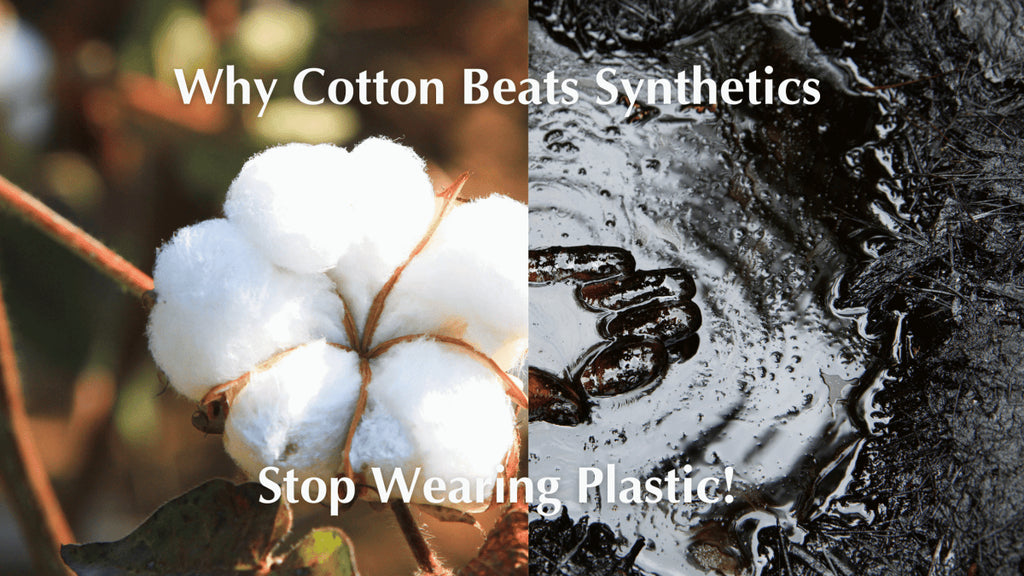Stop wearing plastic! Why Cotton Beats Synthetics: The Best Choice for Towels & Blankets
Posted by JEFF MACOMBER

Why Cotton Beats Synthetics: The Best Choice for Towels & Blankets
When choosing towels and blankets, the fabric you select makes a big difference in comfort, durability, and sustainability. While synthetic fibers have become popular in many textiles, cotton—especially high-quality Turkish cotton—remains the superior choice. In this article, we’ll explore why cotton is better than synthetic fibers and take a look at the history of synthetics in home textiles.
Natural vs. Synthetic: What’s the Difference?
Cotton is a natural fiber, grown from cotton plants, while synthetic fibers such as polyester, microfiber, and acrylic are man-made from petroleum-based plastics (ick). This fundamental difference affects how the materials feel, perform, and impact the environment.
Why Cotton is the Superior Choice
1. Breathability & Comfort
Cotton is naturally breathable, allowing air to circulate and keeping you comfortable in different climates. In contrast, synthetic fibers tend to trap heat and moisture, making them less comfortable for towels and blankets.
2. Absorbency & Quick-Drying Qualities
Cotton towels absorb water quickly and efficiently, making them ideal for drying off after a bath or swim. Synthetic towels, particularly polyester-based microfiber, repel water rather than absorbing it, reducing their effectiveness.
3. Softness & Skin-Friendliness
High-quality cotton, such as Turkish cotton, becomes softer with use and is gentle on the skin. Synthetic fibers often feel plasticky and may cause irritation, especially for those with sensitive skin.
4. Durability & Longevity
Cotton towels and blankets are durable and improve with age, while synthetic fibers tend to pill, break down, and lose their softness over time.
5. Sustainability & Eco-Friendliness
Organic and Oeko-Tex® certified Turkish cotton is free from harmful chemicals and is biodegradable. Synthetic fibers contribute to microplastic pollution during washing, harming marine life and ecosystems.
Common Synthetic Fibers Used in Towels and Blankets
- Polyester – Lightweight and wrinkle-resistant but lacks absorbency.
- Microfiber – Absorbent but less breathable and prone to trapping odors.
- Acrylic – Soft but less durable and can feel plasticky.
- Rayon (Viscose, Modal, or Bamboo Rayon) – Often marketed as bamboo fabric but heavily processed.
- Nylon – Strong but non-absorbent and static-prone.
- Fleece (Polyester-Based) – Warm but not breathable.
Alternatives to these plastic products using natural fibers:
1. Cotton (Alternative to Polyester, Microfiber)
- Best for: Towels, blankets, clothing, home textiles.
- Benefits: Soft, breathable, highly absorbent, durable, and biodegradable.
- Example: Turkish cotton is a superior choice for luxury towels and blankets.
2. Linen (Alternative to Polyester, Acrylic)
- Best for: Bedding, towels, summer blankets, home textiles.
- Benefits: Exceptionally breathable, moisture-wicking, and strong; naturally antimicrobial.
- Downside: Can feel rough initially but softens with use.
3. Wool (Alternative to Acrylic, Fleece, and Polyester)
- Best for: Blankets, throws, winter clothing.
- Benefits: Naturally insulating, moisture-wicking, and durable.
- Varieties: Merino wool (softest), Alpaca wool (light and warm), Cashmere (luxurious softness).
4. Bamboo (Alternative to Rayon, Viscose, Modal, and Microfiber)
- Best for: Towels, bedding, clothing.
- Benefits: Silky soft, antimicrobial, highly absorbent, and breathable.
- Important: True bamboo fabric is natural, but many “bamboo” textiles are actually rayon, which is chemically processed.
5. Hemp (Alternative to Nylon, Polyester, and Acrylic)
- Best for: Blankets, home textiles, and sustainable fabrics.
- Benefits: Strong, durable, naturally antimicrobial, and moisture-wicking.
- Becomes softer with each wash.
6. Silk (Alternative to Polyester Satin and Nylon)
- Best for: Luxury bedding, clothing, scarves.
- Benefits: Lightweight, breathable, temperature-regulating, and naturally smooth.
- Downside: Delicate and requires special care.
7. Alpaca & Cashmere (Alternative to Synthetic Fleece and Acrylic)
- Best for: Warm blankets and luxury textiles.
- Benefits: Ultra-soft, warm, lightweight, and hypoallergenic (especially alpaca).
8. Tencel (Lyocell) (Alternative to Rayon & Modal)
- Best for: Bedding, towels, clothing.
- Benefits: Sustainably sourced from wood pulp (eucalyptus or beech trees), biodegradable, and silky soft.
A Brief History of Synthetic Fibers in Home Textiles
Early Development (1930s–1950s)
- Nylon (1935) – Developed for stockings and military use, later adapted for textiles.
- Polyester (1941) – Commercialized in the 1950s as a cheap, durable alternative to natural fibers.
- Acrylic (1940s) – Used as a wool substitute in blankets.
Mass Production & Popularity (1960s–1980s)
- 1960s–1970s – Polyester and acrylic became widespread in home textiles due to affordability.
- Fleece blankets (1979) – Invented by Malden Mills (now Polartec), leading to mass adoption.
- Microfiber (1980s) – Designed for quick-dry towels but lacked breathability.
Mainstream Use & Market Growth (1990s–Present)
- 1990s–2000s – Microfiber towels and polyester blankets surged in popularity.
- 2000s–Present – Rising consumer awareness of sustainability and health concerns has driven a return to natural fibers, especially organic Turkish cotton.
Final Thoughts: Cotton Wins Every Time
While synthetic fibers may offer affordability and wrinkle resistance, cotton provides unmatched breathability, softness, and sustainability. When investing in towels and blankets, choosing sustainable Turkish cotton ensures comfort, durability, and an eco-friendly choice for your home.
Ready to experience the luxury of Turkish cotton? Explore our collection of premium towels and blankets today!

